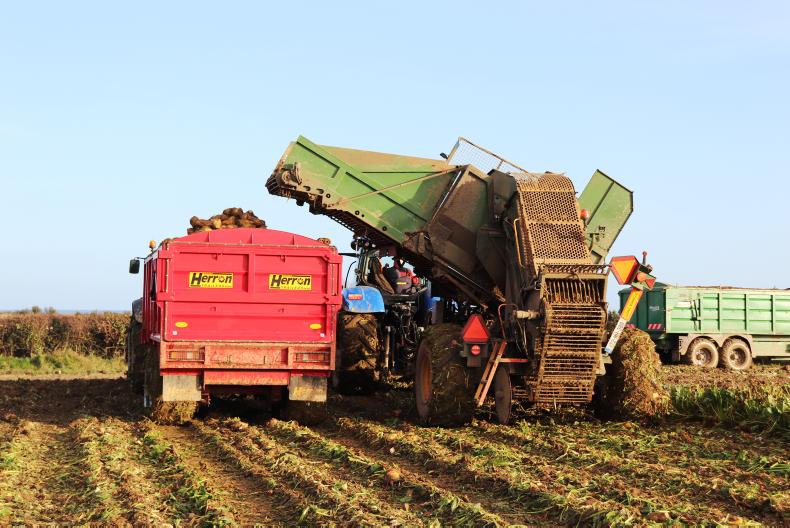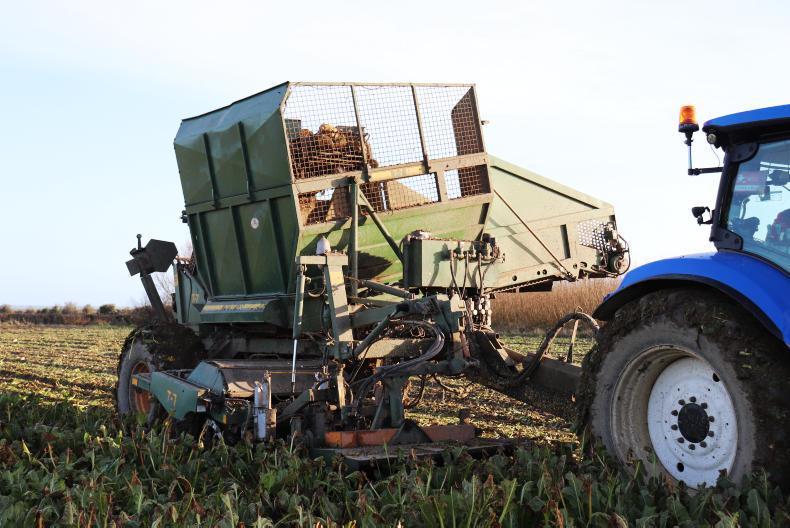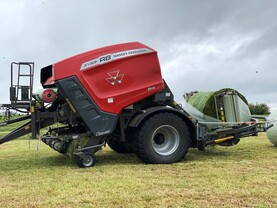Located near Stamullen, Co Meath, Brian Tallon and his son Andrew run a contracting business which consists mostly of tillage work, alongside their own tillage farm.
The Tallons specialise in root crop harvesting. Brian first started harvesting beet in the early 1970s, with a Ransomes harvester alongside his father.

Brian Tallon, Stramullen, Co Meath.
At the time, sugar beet was a thriving industry in Ireland, with beet being grown in as many as 22 counties. As the annual acreage harvested increased, the harvester was upgraded to an Armer Salmon machine which remained in the fleet until 1986. Brian later saw a Danish-built Thyregod harvester in action and was immediately impressed by its performance. He decided to invest in a Thyregod machine and it has been his brand of choice ever since.
As the Irish sugar beet industry dwindled with the closure of factories, the number of acres planted decreased rapidly in the early 2000s. Brian said this affected the business hugely at the time, but in more recent years the number of acres himself and his son Andrew are planting and harvesting is increasing steadily. Brian reckons that nowadays more livestock farmers are buying beet to feed. This, along with the demand for beet to feed anaerobic digesters mostly in the North of Ireland, has helped the industry, with roughly 10,000 acres of beet planted across the country now annually.

The harvester's hopper has a carrying capacity of 8t.
The business
This year, the Tallons have planted just over 300 acres in total, with their Armer Salmon six-row planter, 50 of these acres for themselves and the rest on contract. Not only do the lads harvest beet between October and March, but they also harvest in the region of 200 acres of turnips with a French-built trailed Simon harvester. Beet and turnip harvesting is similar to vegetable harvesting. It is done entirely on demand and as customers require. This differs to silage cutting, where the crop is generally cut at once.
When the lads aren’t harvesting root crops, they are busy in other areas of the business and farming at home. Andrew works with a neighbouring farmer during the summer months, which suits the business.

The 2005 Thyregod T7 harvester lifting Bangor beet.
Thyregod T7s
Brian and Andrew operate two Thyregod T7 trailed beet harvesters, a 2001 two-row machine and a 2005 three-row machine. The three-row harvester is slightly different in that it unloads via a conveyor whereas the other harvester has a tipping hopper. The three-row harvester has been in the fleet five years and the two-row machine nine years.
There are really only two common harvester concepts used in Ireland. The first is the beet lifting concept, which the Thyregod uses. A hydraulically driven turbo topper firstly passes over the leaves of the plant, cutting them and skimming the heads of the beet. Once the leaves are cut, two oppelwheels (similar to a drill’s disc coulter) for each row run either side of the beet and use a prying motion to lift the root out of the ground. From here, the beet enters the turbine wheels and is passed through a cleaning brush and on to the cleaning web before entering the hopper.
The second concept is a technique used on Armer Salmon machines. A belt lifting system pulls the beet out of the ground by its leaves before passing it up the harvester where the leaves are cut. The beet then enters the turbine wheels before being cleaned and sent to the hopper. Both harvester concepts have positives and negatives, with preference generally down to the operator. The Thyregod system suits beet that may have been hit with frost, with withering leaves that no longer can withstand being pulled.
New beet harvesters are almost non-existent in Ireland as few farmers or contractors are harvesting the acreage to justify a new machine. Brian said: “This has left used machines hard come by, especially ones in good working order. While on the other hand these old machines, if in working order, are still worth money.”
Brian is happy with how both machines have performed to date, giving no major issues bar normal wear and tear. When the harvester’s 8t capacity hopper is full, the whole outfit including the tractor weighs in the region of 20t.
Technology on board
Brian said both Thyregod T7 harvesters “were ahead of their time” in terms of electronics from a control point of view. Inside the cab there is an armrest-mounted control box with a joystick and switches which control the whole harvester’s functions. The joystick alone has 26 functions, with everything down to lights being controlled from this box.
The harvesters have their own hydraulic oil supply on board, driven via PTO. This supply takes care of the whole harvester’s hydraulic functions, bar the tipping of the hopper body. There are a number of sensors placed across the harvester which aid in controlling its automatic functions. After the leaves have been topped, a trailing mechanism with a mounted sensor measures the height and position of the beet row, adjusting oppelwheel depth and harvester’s position on the go to suit the rows as they are topped. On the hopper, the elevator has a sensor to adjust its height depending on the fill level within the hopper.
Other features of the harvester include its variable width axle. From the control box, the axle can be extended to a 13ft wide working position for increased stability and retracted to a 11ft 6in transport position. A 900mm stabiliser disc is mounted to the rear of the harvester which can be lowered into the ground on hilly conditions to maintain stability, Brian said.

Brian runs the harvester with his New Holland T7.230.
Maintenance and output
Brian and Andrew carry out all maintenance themselves, overhauling each harvester every two years alternately, meaning one is done every year. This being a fairly costly procedure, costing thousands. Brian said parts such as oppelwheels, turbine wheels and webs are subject to the most wear. Oppelwheels generally last two seasons and webs five or six. Given the age of these machines, sourcing spare parts can prove an issue, although he noted most of his parts are sourced through John Rowe in Co Wexford.
When we visited Brian harvesting near Clogherhead for A&R Collier, he was lifting a relatively new variety called Bangor, a high-yielding soft beet. Brian was impressed with how well the variety was yielding, somewhere in the region of 35t/acre. The size of the root was at times challenging for the harvester to lift. Brian noted that typically 12 acres per day would be good going for a three-row machine, obviously varying slightly depending on the conditions.
So far, the father and son team are happy with how the business is going. Each year sees a steady growth in the number of acres sown and harvested. It has almost got to the point of maxing out the two harvesters.
Moving to a self-propelled machine is becoming more and more appealing. This would eliminate the need to run two tractors and harvesters. Instead, one six-row self-propelled machine would replace the two current units and increase output.
Brian said this move has positives and negatives.
A major positive is increased output and reduced running costs of one machine instead of two tractors and two harvesters. And from a labour point of view, only one operator would be required. Negatives are that the self-propelled machines will lie idle during summer, where a tractor can continue to be used.
Also, some self-propelled machines are not as easily worked on as what the lads are used to.
Size and weight are factors to keep in mind. They can weigh in the region of 30t or more and are not as easily moved from job to job.
But the lads feel this will be a route they will probably take in the near future if the right machine comes up on the market.
The spec
Harvester model:
Thyregod T7 (three-row)
Year of manufacture: 2005
Working width: three-row
Hopper capacity: 8,000kg
Output: 12 acres/day (at 30t/acre)
Working speed: 4-8km/h
Located near Stamullen, Co Meath, Brian Tallon and his son Andrew run a contracting business which consists mostly of tillage work, alongside their own tillage farm.
The Tallons specialise in root crop harvesting. Brian first started harvesting beet in the early 1970s, with a Ransomes harvester alongside his father.

Brian Tallon, Stramullen, Co Meath.
At the time, sugar beet was a thriving industry in Ireland, with beet being grown in as many as 22 counties. As the annual acreage harvested increased, the harvester was upgraded to an Armer Salmon machine which remained in the fleet until 1986. Brian later saw a Danish-built Thyregod harvester in action and was immediately impressed by its performance. He decided to invest in a Thyregod machine and it has been his brand of choice ever since.
As the Irish sugar beet industry dwindled with the closure of factories, the number of acres planted decreased rapidly in the early 2000s. Brian said this affected the business hugely at the time, but in more recent years the number of acres himself and his son Andrew are planting and harvesting is increasing steadily. Brian reckons that nowadays more livestock farmers are buying beet to feed. This, along with the demand for beet to feed anaerobic digesters mostly in the North of Ireland, has helped the industry, with roughly 10,000 acres of beet planted across the country now annually.

The harvester's hopper has a carrying capacity of 8t.
The business
This year, the Tallons have planted just over 300 acres in total, with their Armer Salmon six-row planter, 50 of these acres for themselves and the rest on contract. Not only do the lads harvest beet between October and March, but they also harvest in the region of 200 acres of turnips with a French-built trailed Simon harvester. Beet and turnip harvesting is similar to vegetable harvesting. It is done entirely on demand and as customers require. This differs to silage cutting, where the crop is generally cut at once.
When the lads aren’t harvesting root crops, they are busy in other areas of the business and farming at home. Andrew works with a neighbouring farmer during the summer months, which suits the business.

The 2005 Thyregod T7 harvester lifting Bangor beet.
Thyregod T7s
Brian and Andrew operate two Thyregod T7 trailed beet harvesters, a 2001 two-row machine and a 2005 three-row machine. The three-row harvester is slightly different in that it unloads via a conveyor whereas the other harvester has a tipping hopper. The three-row harvester has been in the fleet five years and the two-row machine nine years.
There are really only two common harvester concepts used in Ireland. The first is the beet lifting concept, which the Thyregod uses. A hydraulically driven turbo topper firstly passes over the leaves of the plant, cutting them and skimming the heads of the beet. Once the leaves are cut, two oppelwheels (similar to a drill’s disc coulter) for each row run either side of the beet and use a prying motion to lift the root out of the ground. From here, the beet enters the turbine wheels and is passed through a cleaning brush and on to the cleaning web before entering the hopper.
The second concept is a technique used on Armer Salmon machines. A belt lifting system pulls the beet out of the ground by its leaves before passing it up the harvester where the leaves are cut. The beet then enters the turbine wheels before being cleaned and sent to the hopper. Both harvester concepts have positives and negatives, with preference generally down to the operator. The Thyregod system suits beet that may have been hit with frost, with withering leaves that no longer can withstand being pulled.
New beet harvesters are almost non-existent in Ireland as few farmers or contractors are harvesting the acreage to justify a new machine. Brian said: “This has left used machines hard come by, especially ones in good working order. While on the other hand these old machines, if in working order, are still worth money.”
Brian is happy with how both machines have performed to date, giving no major issues bar normal wear and tear. When the harvester’s 8t capacity hopper is full, the whole outfit including the tractor weighs in the region of 20t.
Technology on board
Brian said both Thyregod T7 harvesters “were ahead of their time” in terms of electronics from a control point of view. Inside the cab there is an armrest-mounted control box with a joystick and switches which control the whole harvester’s functions. The joystick alone has 26 functions, with everything down to lights being controlled from this box.
The harvesters have their own hydraulic oil supply on board, driven via PTO. This supply takes care of the whole harvester’s hydraulic functions, bar the tipping of the hopper body. There are a number of sensors placed across the harvester which aid in controlling its automatic functions. After the leaves have been topped, a trailing mechanism with a mounted sensor measures the height and position of the beet row, adjusting oppelwheel depth and harvester’s position on the go to suit the rows as they are topped. On the hopper, the elevator has a sensor to adjust its height depending on the fill level within the hopper.
Other features of the harvester include its variable width axle. From the control box, the axle can be extended to a 13ft wide working position for increased stability and retracted to a 11ft 6in transport position. A 900mm stabiliser disc is mounted to the rear of the harvester which can be lowered into the ground on hilly conditions to maintain stability, Brian said.

Brian runs the harvester with his New Holland T7.230.
Maintenance and output
Brian and Andrew carry out all maintenance themselves, overhauling each harvester every two years alternately, meaning one is done every year. This being a fairly costly procedure, costing thousands. Brian said parts such as oppelwheels, turbine wheels and webs are subject to the most wear. Oppelwheels generally last two seasons and webs five or six. Given the age of these machines, sourcing spare parts can prove an issue, although he noted most of his parts are sourced through John Rowe in Co Wexford.
When we visited Brian harvesting near Clogherhead for A&R Collier, he was lifting a relatively new variety called Bangor, a high-yielding soft beet. Brian was impressed with how well the variety was yielding, somewhere in the region of 35t/acre. The size of the root was at times challenging for the harvester to lift. Brian noted that typically 12 acres per day would be good going for a three-row machine, obviously varying slightly depending on the conditions.
So far, the father and son team are happy with how the business is going. Each year sees a steady growth in the number of acres sown and harvested. It has almost got to the point of maxing out the two harvesters.
Moving to a self-propelled machine is becoming more and more appealing. This would eliminate the need to run two tractors and harvesters. Instead, one six-row self-propelled machine would replace the two current units and increase output.
Brian said this move has positives and negatives.
A major positive is increased output and reduced running costs of one machine instead of two tractors and two harvesters. And from a labour point of view, only one operator would be required. Negatives are that the self-propelled machines will lie idle during summer, where a tractor can continue to be used.
Also, some self-propelled machines are not as easily worked on as what the lads are used to.
Size and weight are factors to keep in mind. They can weigh in the region of 30t or more and are not as easily moved from job to job.
But the lads feel this will be a route they will probably take in the near future if the right machine comes up on the market.
The spec
Harvester model:
Thyregod T7 (three-row)
Year of manufacture: 2005
Working width: three-row
Hopper capacity: 8,000kg
Output: 12 acres/day (at 30t/acre)
Working speed: 4-8km/h










 This is a subscriber-only article
This is a subscriber-only article









SHARING OPTIONS: